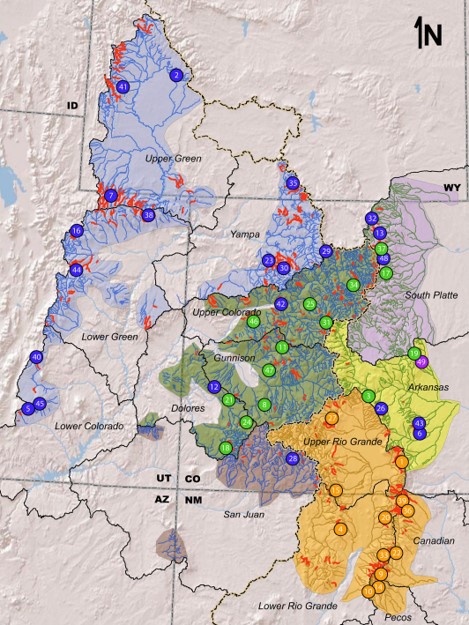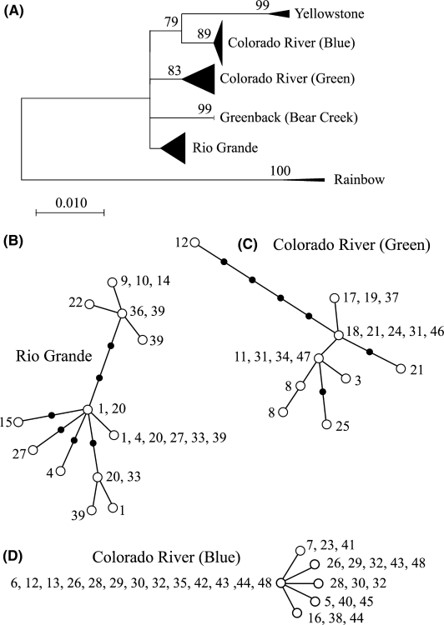Cutthroat trout are distributed across the American and Canadian West. They are a salmonid, related to Pacific salmon as well as rainbow trout, which explains the common hybridization into Cutbows.
Cutthroat Trout Historic Range Map
The historic understanding of cutthroat in Colorado was four subspecies: Greenback east of the Continental Divide, Colorado River west of the Continental Divide, and the Rio Grande in that basin. This distinction is sometimes called the "Geographic Model". For a time, the Greenback was though extinct, initially rediscovered in the 1970s, then properly identified by Metcalf (see below). A fourth subspecies, the Yellowfin, was described the 1890s, but is believed extinct.
Current understanding of Colorado cutthroat subspecies begins with Metcalf et al 2012: Historical stocking data and 19th century DNA reveal human‐induced changes to native diversity and distribution of cutthroat trout. The first to perform genetic analysis, Metcalf presents the "Molecular Model", with six subspecies -- or lineages -- rather than the four of the Geographic. The lineages were:
The biggest discovery by Melcalf was that the only modern Purple Lineage, that is Greenback, trout existed in a single stretch of Bear Creek. The reestablishment of the Greenback had to start anew.
Bestgen et al 2019: Distinct Phenotypes of Native Cutthroat Trout Emerge under a Molecular Model of Lineage Distributions performed another genetic analyis and related these lineages to morphological traits. Since species designations require recognition by physical traits, a goal of this study was to determine if Blue and Green Lineage cutthroat could be separated in this way.
Bestgen et al 2019 Figure 1:

Study area map and sampling sites. Fourteen hydrologic units (fourth‐level hydrologic unit codes) from five western states that comprise the estimated historical range of Colorado River Cutthroat Trout (CRCT ; blue labeled streams), Greenback Cutthroat Trout (green streams), and Rio Grande Cutthroat Trout (RGCT ; orange streams) are named in italics. Ranges are based on estimates of downstream limits of cool water likely to support Cutthroat Trout rather than simply outlining drainage basins (e.g., Behnke 1992). Current conservation populations from which our study populations were randomly drawn are highlighted in red. The historical ranges of various lineages (Metcalf et al. 2012) are represented by shading: the CRCT ‐Blue Lineage (Yampa, upper Green, lower Green, and lower Colorado River geographic management units [GMU s]) is shaded blue; the CRCT ‐Green Lineage (upper Colorado, Gunnison, and Dolores River drainage GMU s) is shaded green; the San Juan River drainage (and GMU ) is shaded brown; the RGCT (upper and lower Rio Grande, Pecos River, and Canadian River GMU s) is shaded orange; the Yellowfin Cutthroat Trout (Arkansas River GMU ) is shaded yellow; and the South Platte River native Cutthroat Trout lineage (South Platte River GMU ) is shaded purple. The lineage of each population sampled in the study (dots) defined by mitochondrial NADH dehydrogenase subunit 2 phylogenies are colored per the lineage ranges, and the number in each dot represents a stream sampled in this study (stream numbers are defined in Table 1).
Bestgen et al 2019 Figure 3

Phylogenetic relationships inferred from 648 base pairs of the mitochondrial NADH dehydrogenase subunit 2 gene for Cutthroat Trout from the southern Rocky Mountains. Four Yellowstone Cutthroat Trout haplotypes were detected in two populations (streams 2 and 44; stream numbers are defined in Table 1 and depicted in Figure 1) and were included in the analysis, as was a Rainbow Trout haplotype detected in a single fish from stream 21 and another in five fish from stream 18. (A) The evolutionary history was developed with the maximum likelihood method, and the tree with the highest log‐likelihood is shown. Percent branching support was evaluated with 1,000 bootstrap replicates. Branches with more than 60% support were retained, while those with less support were collapsed into a polytomy. Phylogenetic analyses were conducted in MEGA 7, with evolutionary distance units representing the number of base substitutions per site. Major clades relevant for this study are displayed as minimum spanning networks, with line segments representing single mutation, for (B) Rio Grande Cutthroat Trout, (C) Colorado River Cutthroat Trout (CRCT ) Green Lineage, and (D) CRCT ‐Blue Lineage. Stream numbers are listed next to open circles that represent sampled haplotypes (GenBank accession numbers MK473752–MK473783), whereas black dots represent unsampled inferred haplotypes.
Introductions and Overviews:
Stable populations of Greenback include:
The Blue Lineage is closely related to the Coloardo River Cutthroat found in Wyoming and Utah. Most Colorado River Cutthroat in Colorado were stocked from Trapper's Lake. Unfortunately, this brood population is no longer pure.
A second discovery by Metcalf were the cutthroat in Hayden Creek (#3 in the figures), which had a genetic marker only otherwise seen in museum specimens originating from Twin Lakes in the 1890s.
CBS4 Denver: Restocking Hayden Creek Colorado River Cutthroat
In 2016, fish from Hayden Creek were rescued from a forest fire and brought to Roaring Judy State Fish Hatchery. While the Green Lineage is not yet recognized as a separate sub-species, this population is the first that is protected and maintained.
Within the Green Lineage, there is a branch with a genetic marker unique to the Front Range of Colorado and a lake just west of the Contintental Divide.
The second unique lineage discovered by Metcalf.
CPR: San Juan Cutthroat thought to be extinct, rescued, from fire.
Durago Herald: Rare cutthroat trout, saved in 416 Fire, set to be released back into the wild
The rediscovery of Greenback and San Juan trout give hope -- however unlikely it may be -- of finding an existing population.